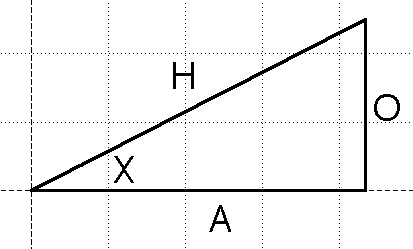Science:Math Exam Resources/Courses/MATH102/December 2011/Question 05/Solution 2
Proceed as in solution one to see that
Solving this equation may appear difficult but if we consider some basic trigonometry, it should be no trouble. Consider this drawing of a right triangle with hypotenuse of length H, and an angle x with adjacent and opposite sides of lengths A, O respectively.
The following relations hold:
To determine the angles, x, that satisfy the relation , we substitute the above relations and get
Therefore, angles with adjacent side length equal to the opposite side length, but with one extending in the negative direction and one in the positive direction are the solutions to our above equation. This implies that the magnitudes of the sides are equal and must occur in the second and fourth quadrants. A right triangle with two sides equal must have angles , and . Hence, the angles of the triangles we require are (in the second and fourth quadrants respectively - see the previous solution for the picture)
and thus, they are our critical points. Evaluating at the critical points and the endpoints we get the following:
Therefore, we can see that this function has a unique absolute maximum and unique absolute minimum:










